Motorcycles and movies have had a long and thrilling ride together. From the rebellious roar of motorcycle gangs to the open road’s promise of freedom, Biker Films have revved their way into our cultural consciousness. This September, the British Film Institute (BFI) is releasing a Blu-ray of Don Sharp’s 1973 cult classic, Psychomania, reminding us of the enduring appeal of these films. This cinematic gem blends occult themes with the raw energy of 70s biker gangs, showcasing why biker films continue to fascinate audiences worldwide.
The obsession with outlaw motorcycle gangs in cinema arguably ignited in the mid-1960s, fueled by Hunter S. Thompson’s book Hell’s Angels and the infamous Altamont Speedway concert incident in 1969. Hollywood quickly responded, delivering a surge of outlaw biker movies. While this genre often portrays motorcycles as symbols of rebellion and menace, they also represent something more profound: the yearning for freedom, self-discovery, and escape.
Here are 10 essential biker films where motorcycles take center stage, each contributing to the rich tapestry of this genre.
1. The Wild One (1953)
Director: László Benedek
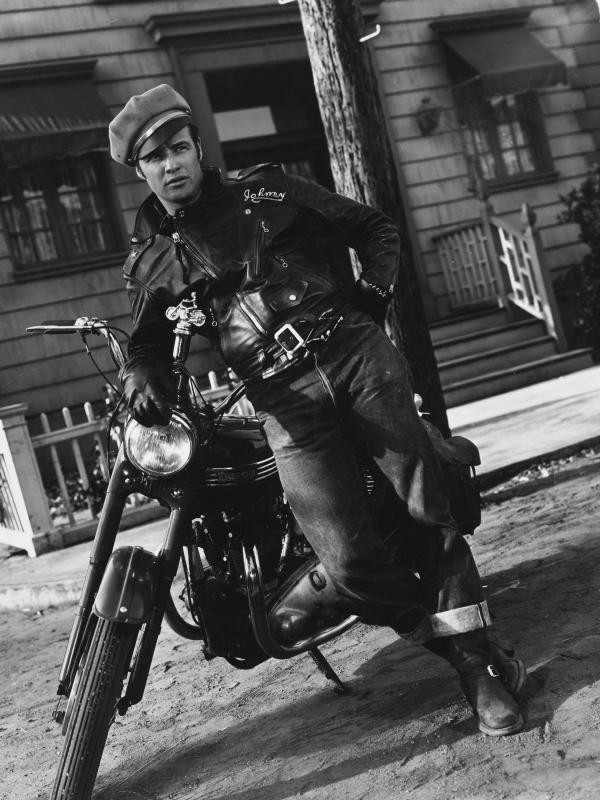 Marlon Brando in The Wild One (1953) leaning on a motorbike, portraying Johnny Strabler, the leader of the Black Rebels biker gang.
Marlon Brando in The Wild One (1953) leaning on a motorbike, portraying Johnny Strabler, the leader of the Black Rebels biker gang.
The Wild One single-handedly propelled motorcycle gangs into mainstream awareness. Marlon Brando’s iconic portrayal of Johnny Strabler, the defiant leader of the Black Rebels, cemented the image of the brooding biker anti-hero. This seminal motorcycle movie established a key narrative trope: a biker gang terrorizing a small town, exposing the underlying tensions within seemingly peaceful communities. Beyond Brando’s magnetic performance, the film incorporated real bikers into the cast, lending authenticity to the Black Rebels’ dialogue and ethos. Brando’s famous line, “What are you rebelling against?” – “Whaddaya got?” perfectly encapsulates the era’s rebellious spirit. Despite its relatively tame depiction of a biker gang compared to later films, The Wild One was highly controversial for its time, facing bans and censorship, ultimately shaping the perception of biker culture for decades to come.
2. The Leather Boys (1964)
Director: Sidney J. Furie
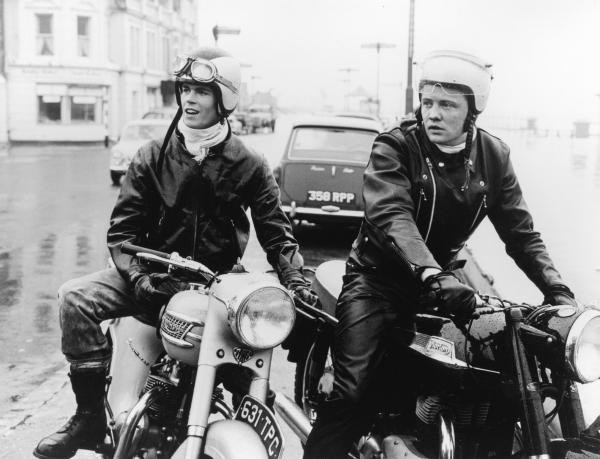 Dudley Sutton and Colin Campbell riding Triumph Bonneville motorcycles in The Leather Boys (1964), representing British rocker culture.
Dudley Sutton and Colin Campbell riding Triumph Bonneville motorcycles in The Leather Boys (1964), representing British rocker culture.
Sidney J. Furie’s The Leather Boys offers a gritty, realistic glimpse into Britain’s rocker subculture, the UK’s answer to American motorcycle gangs. Set against the backdrop of kitchen-sink realism, the film follows Reggie (Colin Campbell) and Dot (Rita Tushingham), young south London rockers who impulsively marry. Their relationship strains under the weight of immaturity and differing desires. As they grow apart, Reggie finds camaraderie with fellow rocker Pete (Dudley Sutton), exploring themes of friendship and emotional connection while remaining oblivious to Pete’s romantic interest. The Leather Boys is a poignant and often bleak exploration of early 60s rocker life and is now recognized as a significant early work in queer cinema, subtly portraying themes of same-sex attraction within the context of motorcycle culture.
3. The Wild Angels (1966)
Director: Roger Corman
 Poster for The Wild Angels (1966) featuring Peter Fonda as Heavenly Blues and Nancy Sinatra as Mike, an iconic outlaw biker film.
Poster for The Wild Angels (1966) featuring Peter Fonda as Heavenly Blues and Nancy Sinatra as Mike, an iconic outlaw biker film.
Released in the same year as Hunter S. Thompson’s groundbreaking exploration of outlaw bikers, Roger Corman’s The Wild Angels provided Peter Fonda his first major film role. Fonda embodies ‘Heavenly Blues’, the nihilistic leader of a fictionalized San Pedro chapter of the Hells Angels. The plot kicks off when a motorcycle recovery mission for a stolen bike leads to the hospitalization of the gang’s second-in-command, ‘Loser’ (Bruce Dern). Heavenly Blues and his “old lady,” ‘Mike’ (Nancy Sinatra), orchestrate a daring hospital breakout. However, Loser’s subsequent death triggers a chaotic sequence where the gang desecrates a church and clashes violently with local townsfolk. The film’s visual style is a unique blend of biker iconography – motorcycles, leather jackets, Nazi symbols – juxtaposed with beatnik elements like black skivvies and berets, all underscored by a surf music soundtrack. The Wild Angels further blurred the lines between fiction and reality by featuring actual members of the Hells Angels and Coffin Cheaters motorcycle clubs.
4. The Born Losers (1967)
Director: Tom Laughlin
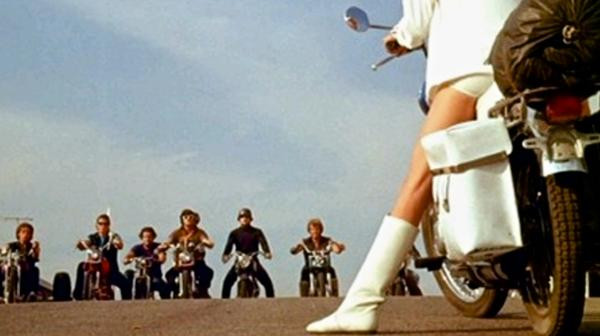 Bikers menacingly surround a car in The Born Losers (1967), highlighting the film's portrayal of outlaw motorcycle gangs.
Bikers menacingly surround a car in The Born Losers (1967), highlighting the film's portrayal of outlaw motorcycle gangs.
The Born Losers marked the debut of Billy Jack (played and directed by Tom Laughlin across four films), a complex character—part enigmatic loner, part nature enthusiast, part Native American, and part former Green Beret—who becomes a protector figure for the counterculture. In this initial installment, a ruthless biker gang terrorizes a small Californian coastal town, committing violent acts against young women and intimidating victims to silence. Billy Jack is drawn into the fray when he defends Vicky (Elizabeth James), one of the assaulted girls. Despite its low-budget, made-for-TV aesthetic and initial box office failure, The Born Losers resonated deeply upon re-release, earning over $40 million. The film authentically captures the countercultural zeitgeist, addressing generational divides, racism, and the struggles of Vietnam veterans reintegrating into society. Importantly, it sympathetically explores the impact of sexual violence, moving beyond mere exploitation and adding a layer of social commentary rare in exploitation biker films.
5. The Girl on a Motorcycle (1968)
Director: Jack Cardiff
 Marianne Faithfull in The Girl on a Motorcycle (1968), wearing a leather suit and close-up on a motorcycle, symbolizing female freedom.
Marianne Faithfull in The Girl on a Motorcycle (1968), wearing a leather suit and close-up on a motorcycle, symbolizing female freedom.
The Girl on a Motorcycle (also known as Naked under Leather) presents a unique perspective on biker movies. Frustrated housewife Rebecca (Marianne Faithfull) leaves her sleeping husband to embark on a journey to her lover, Daniel (Alain Delon), a university professor. Embracing the spirit of the 60s, Rebecca makes the trip clad in a full leather suit atop a Harley Davidson, a gift from Daniel. Adapted from a novel by surrealist writer André Pieyre de Mandiargues, the film prioritizes visual and sensory experience over dialogue and plot. It’s rich in psychedelic effects and nudity, particularly featuring Faithfull. The film explores the motorcycle as a symbol of female emancipation, a twist on the common late-60s trope of housewives rebelling against mundane lives. However, this theme is tempered by a downbeat ending. Director Jack Cardiff, renowned for his Technicolor cinematography in classic films, brings a distinctive visual flair to this cult biker film.
6. Easy Rider (1969)
Director: Dennis Hopper
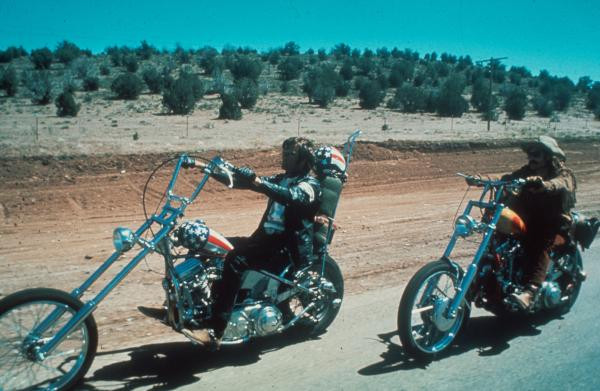 Peter Fonda and Dennis Hopper riding Harley Davidson motorcycles in Easy Rider (1969), an iconic image of freedom and the open road in biker cinema.
Peter Fonda and Dennis Hopper riding Harley Davidson motorcycles in Easy Rider (1969), an iconic image of freedom and the open road in biker cinema.
1969 was a landmark year for biker films, with at least a dozen releases. Easy Rider stands as the most iconic and influential of this era. The film follows Wyatt (Peter Fonda) and Billy (Dennis Hopper, also directing), who ride from Los Angeles to New Orleans on Harley Davidson choppers (purchased second-hand from the LAPD) in a quest to ‘discover America’. Their journey exposes them to a diverse cross-section of American society – from welcoming dirt farmers to hostile rednecks and open-minded freaks. They encounter George Hanson, a small-town lawyer played memorably by Jack Nicholson, and experience a psychedelic graveyard scene with two prostitutes (one played by a young Karen Black). Easy Rider oscillates between feel-good Americana and a post-Summer of Love sense of disillusionment. While its counter-spiritualism may feel dated today, its visual style, soundtrack, and themes of freedom and societal critique cemented its place as an American classic. It is considered a foundational film of the New Hollywood era, significantly impacting subsequent motorcycle movies and independent cinema.
7. Electra Glide in Blue (1973)
Director: James William Guercio
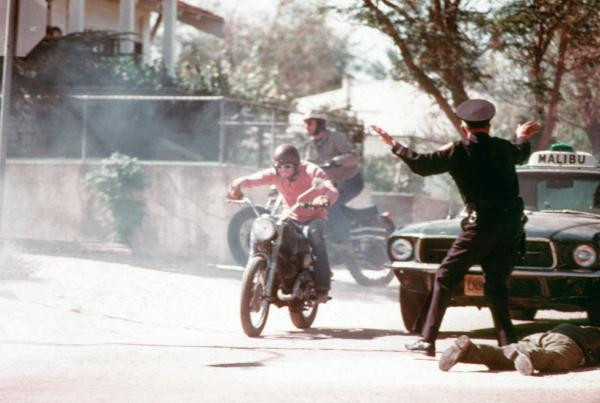 Robert Blake as a police motorcyclist in Electra Glide in Blue (1973), riding a Harley-Davidson Electra Glide, a unique biker film.
Robert Blake as a police motorcyclist in Electra Glide in Blue (1973), riding a Harley-Davidson Electra Glide, a unique biker film.
Electra Glide in Blue takes its name from the Harley-Davidson Electra Glide motorcycle ridden by its protagonist, John Wintergreen (Robert Blake), a mild-mannered Vietnam veteran and Arizona highway patrolman. Wintergreen, bored with routine duties and disillusioned by his colleagues’ attitudes, yearns to become a homicide detective. His ambition is ignited when he arrives first at the scene of an apparent suicide and is mentored by Detective Poole (Mitchell Ryan), a hard-edged, right-wing officer. This neo-noir gem is the sole directorial effort of James William Guercio, a Grammy-winning music producer and former guitarist for Frank Zappa. Enhanced by Conrad Hall’s breathtaking cinematography, Electra Glide in Blue offers a sharp and poignant portrayal of America’s fading counterculture and the social repercussions of the Vietnam War, setting it apart from typical biker gang films.
8. Stone (1974)
Director: Sandy Barbutt
 Bikers in black helmets from Stone (1974), an Australian biker film precursor to Mad Max, showcasing intense biker imagery.
Bikers in black helmets from Stone (1974), an Australian biker film precursor to Mad Max, showcasing intense biker imagery.
A lesser-known precursor to the Australian Ozploitation classic Mad Max, Stone blends Australian road culture, biker gangs, and elements of early 70s paranoid conspiracy thrillers. The film centers on Stone (Ken Shorter), an unconventional policeman and former real-life cop, who goes undercover with a satanic outlaw motorcycle club, the Gravediggers, to investigate a series of murders targeting its members. Directed by television actor Sandy Harbutt, who sadly passed away shortly after the film’s release, Stone features iconic Australian actors including Rebecca Gilling, Bill Hunter, and Helen Morse. Initially dismissed by critics, Stone became a massive hit in Australia, propelled by its impressive stunt work and grand spectacle, far exceeding its low budget. Hundreds of real-life bikers participated in the film’s most famous scene – a highway funeral procession for a deceased Gravedigger – reportedly paid in beer, adding to its raw and authentic feel.
9. Quadrophenia (1979)
Director: Franc Roddam
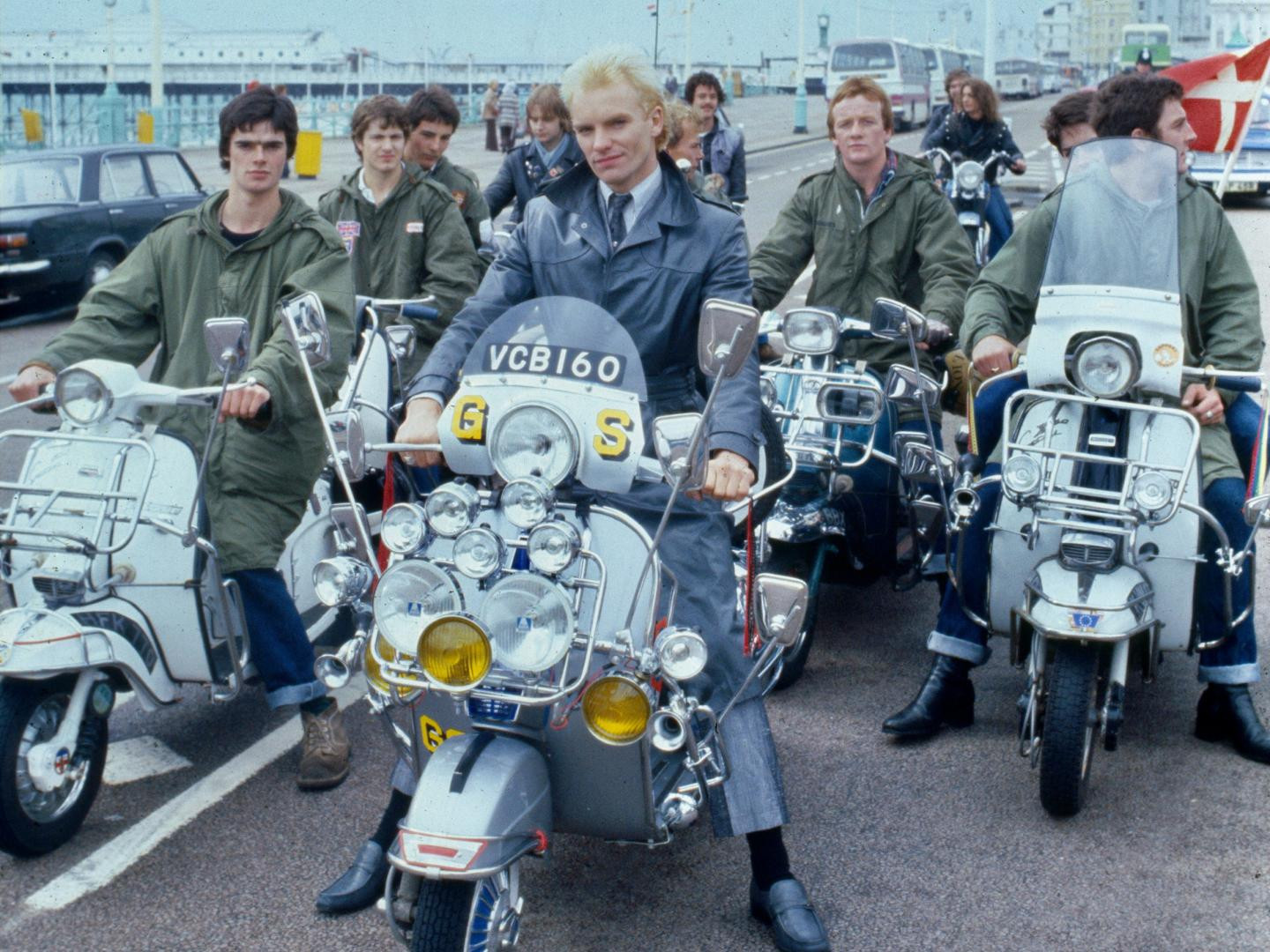 A group of mods on scooters in Quadrophenia (1979), depicting youth culture and scooter gangs, a different style of biker film.
A group of mods on scooters in Quadrophenia (1979), depicting youth culture and scooter gangs, a different style of biker film.
Quadrophenia explores youth discontent in 1960s London, leading up to the infamous 1964 bank holiday riots between mods and rockers. Jimmy (Phil Daniels) embodies the classic juvenile delinquent, stuck in a dead-end job, living for weekend scooter escapades with his mod friends, and pursuing the aloof Steph (Leslie Ash). While the central narrative of Jimmy’s disillusionment with the mod lifestyle may seem straightforward today, Quadrophenia retains its impactful portrayal of pre-swinging London and its two dominant youth subcultures. The extended riot scenes in Brighton possess a visceral energy, complemented by a classic soundtrack by The Who. Though focused on scooters rather than motorcycles, Quadrophenia remains a crucial film for understanding youth rebellion and gang culture of the era, offering a British perspective within the broader landscape of biker films.
10. The Motorcycle Diaries (2004)
Director: Walter Salles
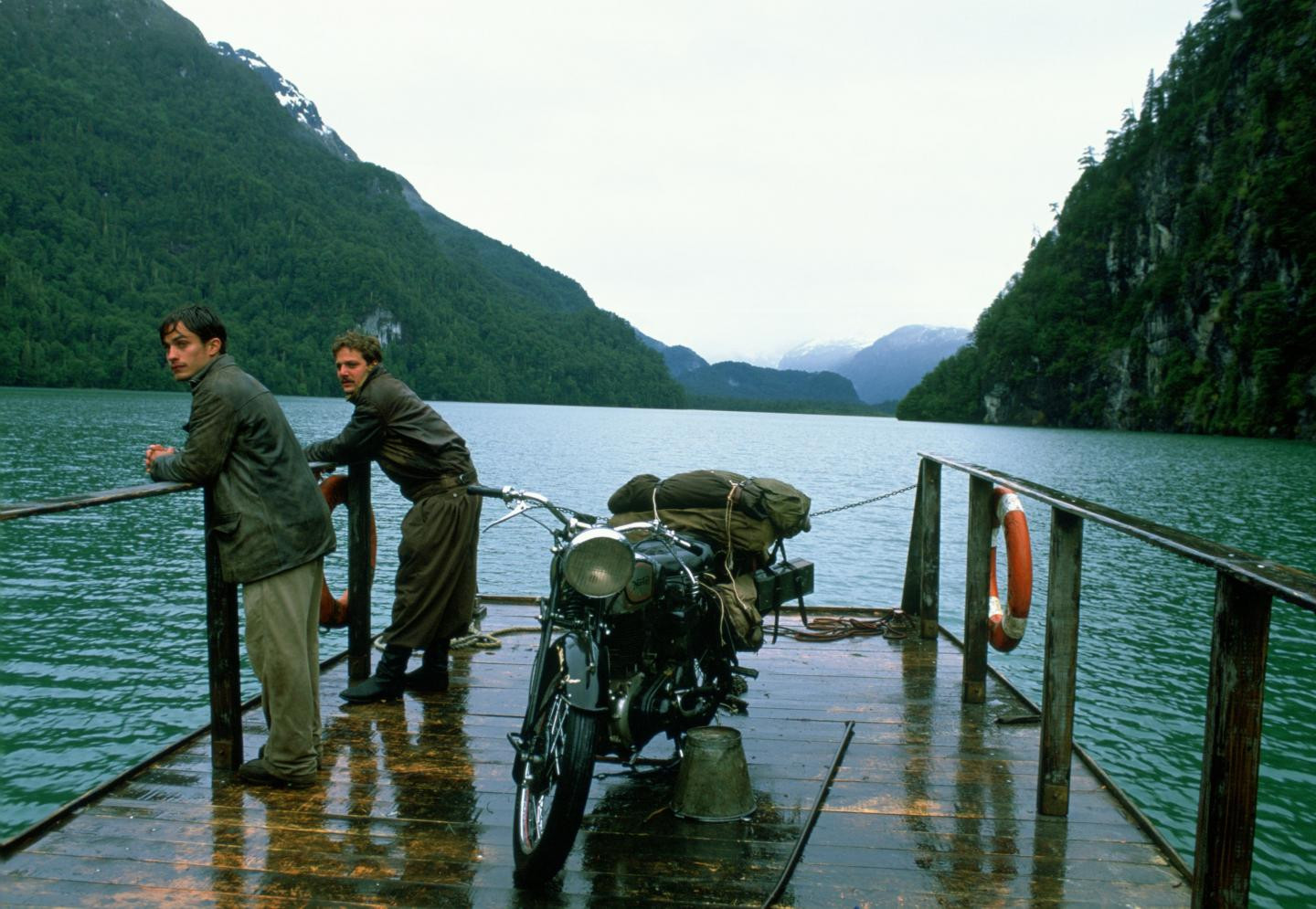 Gael García Bernal and Rodrigo de la Serna on a motorbike on a boat in The Motorcycle Diaries (2004), a biographical journey rather than a typical biker film.
Gael García Bernal and Rodrigo de la Serna on a motorbike on a boat in The Motorcycle Diaries (2004), a biographical journey rather than a typical biker film.
Walter Salles’ The Motorcycle Diaries offers a stark contrast to the violent imagery typically associated with motorcycle-themed films. It depicts the transformative journey of medical student Ernesto ‘Che’ Guevara (Gael García Bernal) and his friend Alberto Granado (Rodrigo de la Serna) across South America in the early 1950s. Based on Guevara’s travelogue and Granado’s memoir, the film presents a coming-of-age story against a backdrop of social and political awakening. Far removed from outlaw motorcycle gangs, the two protagonists begin their expedition on a dilapidated 1939 Norton 500 nicknamed ‘The Mighty One’. When their bike breaks down, they are forced to engage more deeply with the people they encounter, witnessing firsthand the poverty, hardship, and political oppression prevalent across the continent. The Motorcycle Diaries is a genuinely moving and visually stunning film, showcasing powerful performances and eye-catching cinematography, proving that motorcycles can be vehicles for profound personal and social discovery on screen.

